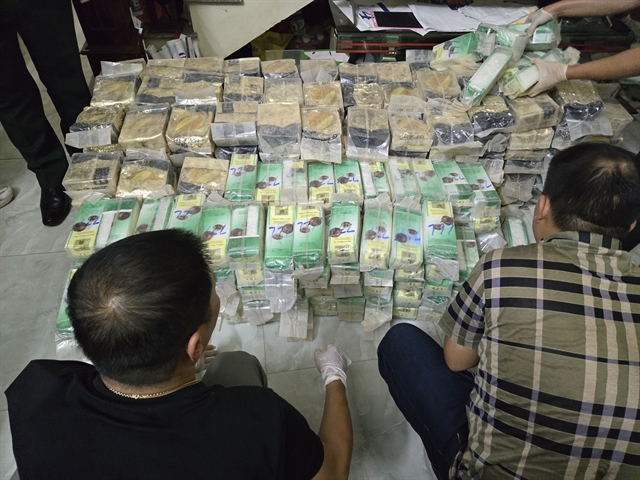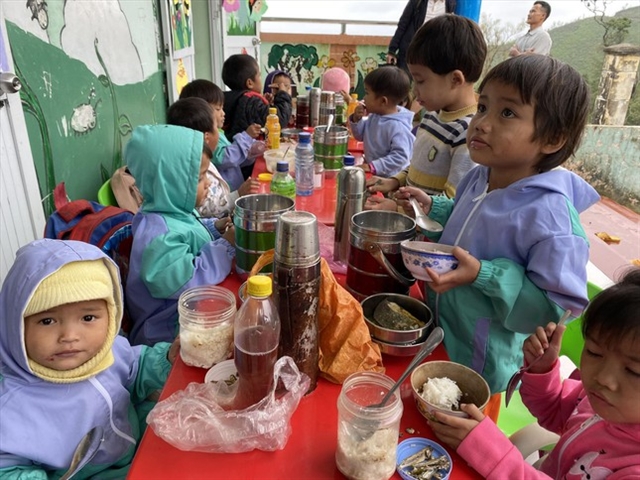 Society
Society

At 1,400 metres above sea level in Quế Hamlet, the life of the Cor people remains simple and almost isolated from the rest of the world.

|
| The women at Quế Hamlet. — Photo tienphong.vn |
QUẢNG NGÃI — At 1,400 metres above sea level in Quế Hamlet, the life of the Cor people remains simple and almost isolated from the rest of the world.
Located at the foot of Cà Đam Mountain, Quế Hamlet is 23 kilometres away from the centre of Trà Bùi Commune in Quảng Ngãi Province. The road leading to the hamlet is full of steep, fog-covered slopes, while the higher ground experiences colder temperatures.
All people here are of the Cor ethnic minority, with most making a living by growing rice and cassava. Without a stable source of income, the poverty and near-poverty rates reach almost 100 per cent.
“Quế Hamlet is divided into two residential areas, number 7 and 8,” Hồ Văn Liên, a local resident, told Tiền Phong (The Vanguard) Newspaper as he opened the gate to the hamlet.
“This gate wasn't here before, but a few days ago some visitors stopped by and spent the night here,” he explained.
“Concerned about COVID-19, the people here decided to install this gate and keep it locked, to prevent children from running out and meeting strangers, and also to stop people from outside coming in."
Thanks to his agility and resourcefulness, Liên was assigned to be in charge of healthcare for the hamlet after several basic training courses despite having only finished secondary school.
In addition to promoting and providing education on public health, first aid and common healthcare, Liên is also tasked with a “grand mission”: supporting women in labour.
“Most women here give birth at home, with help from the midwives,” said Liên. “For difficult cases where the mother does not give birth within one to two days, we would call the ambulance to take them to Sơn Hà District’s medical centre, as it is closer than Trà Bồng’s.”
“Back in the days when people did not know much, they would start praying if the mothers could not go into labour, so there were fatalities due to difficult childbirth. The situation has gotten much better now,” said Liên.
Liên’s wife, three years younger than him, also gave birth at home. All four of their children were brought into the world with the help of one midwife – Hồ Thị Hiền, Liên’s mother.
At the age of 57, Hiền is considered a “veteran” midwife in Quế Hamlet. Having lost her own mother at a tender age, she often followed other women in the village while they helped deliver babies. Hiền knew how to be a midwife before becoming a wife and a mother.
There are four or five midwives like her in the village, most of them deliver babies for their daughters and sisters. The practice then passes on from one generation to the next.
However, Cor people work in the fields and the forests during the day, thus not every woman goes into labour with the help of a midwife. Next to Liên’s house, a mother once had to give birth alone as no midwife was available.
“It was only when the baby was born that our older child ran out and find someone to cut the umbilical cord, luckily it was an easy case,” recalled Hải, the father of the child.
At another hill that is one rocky, steep road away from Liên’s, Hồ Thị Lý cradles her child as she plays with the other girls next door.
Married since she was 16, Lý is now the mother of two children, one aged 3 and the other 10.
“Both of them were born at home. I experienced abdominal pain for a few hours, and then I gave birth. It is the same for all women around here,” said Lý.
At the same age as Lý, many are already mothers of three, or four. In this area, unmarried women in their twenties are considered old.
“Women [here] marry young. Poverty leads to a lack of education, and then they would stop going to school after secondary school, and get married. Recently due to the pandemic and campaigns from the authorities, the situation has gradually improved,” Liên said.
Life here is no less challenging for teachers and students. At a kindergarten in the hamlet’s Residential Area 8, Thu Hà is taking care of fourteen children aged three to five.

|
| Children have lunch at a local kindergarten in Quế Hamlet. — Photo tienphong.vn |
“All of them bring their own lunch,” said Hà, “most have rice with dried fish, rarely do they have meat to eat."
In this season, Hà has to stop teaching at around two to three in the afternoon as fog covers the mountain.
As the last student is picked up, Hà begins crossing two hills to return to her boarding house, which she shares with another teacher in Residential Area 7.
Mỹ Châu, a teacher in Residential Area 7, said: “Cellular coverage is still limited here in Quế Hamlet. We have to run out to the cell tower whenever we want to call home, and even then the signal is very weak and unstable.”
“Fortunately here we can hold in-person classes, it is impossible to teach online – there is no signal, and the parents cannot afford smartphones and computers,” Châu said.
There are six teachers in Quế Hamlet in total. A few years back, children were very shy of strangers, and often stopped going to school after the harvest season or the new year’s holiday.
People’s awareness has improved, so the situation has gotten significantly better.
“The locals are not well-off, but they are incredibly friendly and sincere,” said Tài, a teacher at Trà Bùi Elementary School.
“We teachers pay for school supplies ourselves, as the region is underprivileged, the stores are too far away, and the parents don’t know what to buy either,” Tài said.
“As for reimbursements, it is hard to tell. Parents can pay back the teachers when the students receive allowance support. If they are in too difficult a situation, we teachers would not ask for the money back.”
“We just hope the children learn how to read, know how to do maths, that’s already great,” Tài said.
According to Hồ Ngọc Ninh, Vice Chairman of Trà Bùi Commune People’s Committee, Quế Hamlet has 84 households with a population of over 350.
“Due to the cold climate, agricultural and farming production is difficult,” said Ninh, “Although there have been multiple poverty-reduction programmes, the results were not as effective as expected.” — VNS




